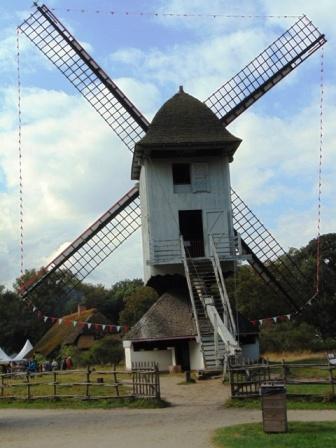Windmills grind grain, pump water and saw wood (and produce electricity).
Wind energy can be used by sailing to push or run ships (and surfboards) or vanes forward.
Wind power is durable, reduces the use of fossil fuels, pollution and CO2 emissions, can generate energy locally and makes us less dependent on oil-producing countries.
Disadvantages are that the wind speed is highly variable and difficult to predict, their integration into the landscape and the burden for birds, bats and residents through shadow and noise.
 Wheeling (or upwinding) is putting the sails right on the wind (by turning the mill or the cap).
Wheeling (or upwinding) is putting the sails right on the wind (by turning the mill or the cap).
An inner wheeler is from the inside rotated to the wind .
In a smock rotates only the hood with the sails (horizontal).
The windmillin Bokrijk open air museumweighs 35tons,andwas turnedintothe wind inits entirety witha biglever.
In traditional windmills the sails rotate counterclockwise as one is facing the sails standing before the mill. Experimentally has previously be found that those mills turned best.
In contrast, wind turbines rotate in the Northern Hemisphere, the rotor blades seen with the wind at your back clockwise. This would be more efficient.
There may be a division made according to the product that mills create or proces.
The grain windmill is probably the most used. The mustard mill grinds tiny mustard seeds, the malt mill malt. There were shell sand mills, hulling mills, grinding mills, snuff mills, ropemills....Star Mill in Eksel (Belgium) can mill 1,000 kilos of grain per hour to meal at 3 to 4 Beaufort.
The chalk mill grinds chalk and can also be a paint mill. Crushed chalk is used as a filler for putty or filler. Also trass mills often grind chalk. This was used for cement and stucco. Paint mills also hammer (linseed) oil.
In the copper mill plates were beaten for making coins (penny plates), shipbuilding, brewing kettles ed.
The powder mill processed ingredients for gunpowder. Because of the danger of sparks there are no iron parts in the installation.
Rags are torn into small pieces and with hammers or knives chopped or crushed in the paper mill.
In a polder mill is driven work (the auger or paddlewheel) in a fixed position. The paddlewheel is used to lift water about five meters higher. With the auger (Archimedes screw) could be from the 19th century, the head increases to 4 to 5 meters.
Mid 19th century was in the U.S. a multi blade mill developed to pump water up out of the ground. He is also mentioned here as American windmill or American wind motor and used for drainage. A vane ensures that the mill is always focused on the wind. The mill is working already at a low speed, but is less resistant to storm.
The crusher mill (hemp beater mill, hemp crushers) was used to break the woody parts of dried flax and hemp stalks and to remove them, so that the fibers were released.
The tan-, (bark or run) mill grinds oak bark (or tan bark) fine between the millstones. By adding water to this, tannin was made. It is used for tanning leather.
To me mills are the beginning of an industrial revolution: labor is not only provided by human (or animal), but by wind and water. In this phase, fortunately without pollution from burning fossil fuels.
It is, after using the wheel and steel forging, a revolution with many features and a high degree of specialization and economies of scale. It is the beginning of engineering and mechanics. A mill has to be seen in operation.
I remember the smell, the dust, the hot meal. And for some reason the sharp knives that were there. To cut flax rope in order to bind and close the bags. It was pure magic, when together with the fine dust in the sunlight, a heavy grain bag floated up. The miller was not a bruiser. The bag heavy and cumbersome. I could as a child not get it in motion. But by ropes, pulleys and mill power had the miller no qualms. In those days bags were still 50 kilograms weight and more.
The woodwork with his cogs and gears, shake baking and other mysteries is incredibly clever and ingenious, incredibly beautiful and strongly built. Definitely worth to spend several trips to at the annual open Mills Day. If you want to know something of mills and their operation then join as volunteer to maintain them and keep them working.
In the Golden Age the Zaan area was a gigantic industrial mill area. Thousands of windmills sawed wood from Scandinavia for shipbuilding, and for the paper industry which flourished since 1650. Until 1795, the paper mills continued to run. The mills were grinding polders dry. They ground clean water for productions up of great depth. They ground corn, sunflower seeds, and they ground linseed oil to the already gigantic coatings (oil) industrie.
The process of pressing oil consists of two main parts: creating fine seed among large spinning side stones upright like a wheel running, and pressing the hot cooked meal in a press block by ramming blocks and wedges. Oil which is intended for paint is cold pressed.
Unfortunately, a lot of knowledge about the oil mill and other milling techniques in the past century has been lost.
